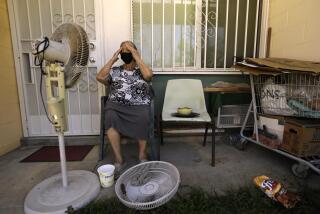Tapping In to Fresh Air
- Share via
QUESTION: We have an energy-efficient house, and I heard about “sick house syndrome.” We use an air cleaner, but the air still seems stale. What is the best way to get fresh air indoors without increasing our utility bills?
ANSWER: The Environmental Protection Agency has listed poor indoor air quality as one of the top five environmental issues in the United States. Ideally, a house should have one complete air-change every two to three hours.
An unhealthy energy-efficient airtight house can have carbon dioxide levels two to six times higher than outdoors. This can make one feel sluggish and sleepy.
Other common pollutants come from household chemical cleaners, gases from furniture and carpet, plant spores, mold, cooking, even air fresheners.
Installing a heat recovery ventilator with adjustable fans is the most efficient method to bring in fresh outdoor air year-round. The designs range from ducted whole-house models to portable window units. Small fans use about 100 watts of electricity; about as much as a light bulb.
Heat recovery ventilators use a heat exchanger core. In winter, incoming fresh outdoor air picks up heat from outgoing stale indoor air. The stale indoor air and fresh outdoor air paths are sealed from one another.
Ventilators typically save from 65% to 90% of the energy from the outgoing stale air. In summer, the outgoing cool indoor air precools the incoming fresh air. If you have allergies, select a model with a pre-filter for the incoming air.
In hot humid climates or if you want to control mold and dust-mites for allergy relief, select a model with an enthalpy (energy) heat exchanger. As it transfers heat between the air paths, moisture is exchanged too.
Small window units are the easiest to install. These lightweight units mount in windows like air conditioners. Larger through-the-wall models are also easy to install. The fresh air gradually circulates throughout the house.
Whole-house models can be ducted into your existing furnace ducts or have their own duct systems. The stale air intakes are often located in the bathrooms, kitchen and laundry. The fresh air outlets are located in the living room, dining room and bedrooms.
There are several control options for the fans in a ventilator. A variable-speed adjustment provides the most precise control. Most ventilators can also be set for timed operation. In humid areas, choose one with a humidistat control where incoming and outgoing fan speeds are balanced for the best ventilation.
*
Write for Update Bulletin
No. 559 showing a guide of 21 whole-house and window ventilators listing air-flow rates, heat exchanger types, efficiencies, warranties, prices and a size selector chart. Please include $20 and a business-size self-addressed, stamped envelope.
To rush a bulletin delivery, e-mail Dulley or read 150 previous columns, check out
https://www.dulley.com
Letters and questions to Dulley, a Cincinnati-based engineering consultant, may be sent to James Dulley, Los Angeles Times, 6906 Royalgreen Drive, Cincinnati, OH 45244.
(BEGIN TEXT OF INFOBOX / INFOGRAPHIC)
Update on Alternative Energy
James Dulley has written a new 208-page book, “Sun-Wood-Wind,” a compilation of 51 of his solar and alternative energy Update Bulletins and columns.
Included are 450 manufacturers of new solar, wood and wind energy products; 21 low-cost do-it-yourself solar projects; and 13 passive solar house floor plan layouts and exterior illustrations.
To order this book directly from James Dulley for $12.95 (includes postage and handling) with check or money order, send your order to James Dulley, New Book, P.O. Box 54987, Cincinnati, OH 45254.






